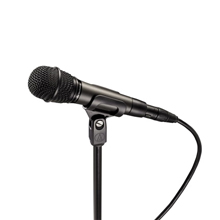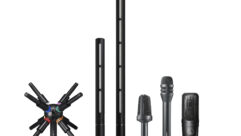

Audio-Technica ATM610a & AT2005USB Microphones Review
Jul 13, 2012 3:37 PM,
Reviewer: John McJunkin
Two quality mics to fit a range of applications.
Audio-Technica ATM610a
Recently I handled an upgrade for a government agency client who specified that they’d like a pair of wireless mics to facilitate the telephone transmission and recording of public comment during their conferences. I eventually chose mics with integrated transmitters, but I strongly considered pairing a traditional handheld mic with a plug-in transmitter. In consideration of in-ceiling speakers from which I wanted to wring every last bit of gain before feedback, I decided to specify cardioid mics, possibly even considering super- or hypercardioids to help reduce the potential for feedback. I had heard of Audio-Technica’s new ATM610a hypercardioid and requested one for evaluation.
I was also aware that Audio-Technica (A-T) had introduced a new USB microphone, and having watched in anticipation from the sidelines when the company introduced its first USB mic, I was keen to see what the new mic was all about. I knew that unlike previous A-T USB mics, the AT2005USB offers a traditional XLR output in addition to its USB digital output, but I discovered another pleasant surprise that enhances the functionality of the mic for the application I had in mind. I have clients who want to make recordings of monologues or dialogues in their offices, during conferences, or while on the road at conventions or tradeshows. Carrying a mic, cabling, mixer, and recording medium can get a little unwieldy, so it would be nice to have a simple USB mic that plugs directly into a laptop or other portable USB-appointed device and also facilitates monitoring of the recording in realtime. This mic does that, and if you do need the capacity to plug in via balanced XLR mic cabling to a traditional system, it fits that bill as well. Audio-Technica sent me one of these to evaluate too.
The ATM610a is a traditional handheld microphone, 7in. long and just shy of 2in. in diameter at its widest point—the middle of the metal mesh windscreen surrounding the mic’s dynamic capsule. Audio-Technica employs its multi-stage windscreen with this mic, as the company does with many of its mics now. The principal component of the windscreen is a foam insert that is cut in such a way that the openings into the mic’s phase-shift network are clear, ensuring maximum off-axis phase cancellation and hence, high directionality. Indeed, this mic’s pick-up pattern is limited to 100 degrees, with deep rejection of the acoustical input 180 degrees off axis from the front of the mic. This makes it a good choice for music vocals and for speech. In the specific use I considered, the off-axis rejection is important to avoid feedback from in-ceiling speakers, and since the mics would be used in a free-roaming handheld way, the hypercardioid is the best way to do this. The mic’s users are instructed to hold the mic parallel with the ground, locate the business end of the mic an inch or so off the corner of their mouth, and point it at an angle toward the center of the mouth. This increases proximity effect a little, but it’s easily tamed with just a touch of equalization, and the off-axis rejection all but eliminates feedback.
Regarding frequency response, the manufacturer publishes 40Hz to 16kHz, and without objectively measuring it, this sounds honest to my ear when listening to the mic. Not many human voices have a significant amount of 40Hz energy, so the mic gets where it needs to be in the low end, and the 16kHz top end is certainly sufficient. There is a moderately broad bump of about 6dB centered around 4kHz, which nicely accentuates the intelligibility frequencies, and an additional, smaller bump centered around 12kHz that adds a little “air” to the mic’s output—a pleasant addition that dynamic mics aren’t known to deliver. Otherwise, the rest of the spectrum is flat, smooth, and sounds good. I tend to scoop the mids a bit, and did so with this mic. I was very happy with the results. The mic delivers a good solid signal with no notable self-noise.
1
Audio-Technica ATM610a & AT2005USB Microphones Review
Jul 13, 2012 3:37 PM,
Reviewer: John McJunkin
Two quality mics to fit a range of applications.

Audio-Technica AT2005USB
The AT2005USB mic is 7.25in. long and a little more than 2in. in diameter. Its flared cylindrical shape gives way to its metal mesh windscreen along the way, which is truncated and hence flat at its end. It’s also flat at the rear end, and what you’ll find there distinguishes this mic from virtually all others. There is the traditional 3-pin XLRM connector taking up just over half the real estate, but it has three unlikely neighbors: a USB Mini B jack, a 3.5mm headphone jack, and a recessed volume control. This is where the real strength of this microphone exists. The two outputs facilitate use in a broader range of applications, and the monitor headphone jack and level control enable the user to quickly and easily record either monologues or dialogues in numerous settings, including in an office, boardroom, tradeshow floor, or hotel room. A recording can be made and then sent via email or cloud upload to someone who can further edit and polish it. Audio-Technica’s initial foray into USB microphones, the AT2020USB is a great mic, but it lacks the capacity for monitoring and/or a traditional XLR output. The AT2005USB is a dynamic mic with a cardioid pattern that adds these capabilities. It’s down 10dB at 50Hz, and quite flat from about 150Hz to 1.5kHz, above which is a broad bump between 1.5kHz and 15kHz with a maximum boost of roughly 6dB. This increase in output from the intelligibility frequencies up through the “air” frequencies makes this a great mic for speech, and makes recording podcasts and other Internet-oriented productions very easy.
Both of these mics sound great and they effectively meet the needs specific to the applications for which they’re touted. In the case of the ATM610a, mobility would be a welcome improvement, and is achievable via the addition of a plug-in transmitter and receiver combo, readily available from numerous manufacturers. Indeed, mics with integrated transmitters abound, but this mic sounds good enough and delivers such an extraordinarily tight pattern that it wouldn’t warrant using a third-party transmitter/receiver pair.
The AT2005USB is a versatile mic, facilitating voice recording in a number of environments irrespective of whether a traditional balanced mic cable or a more modern USB output is necessary. The built-in monitoring capacity eliminates the need for additional hardware, making the mic portable and complete. It has increasingly made more sense for contractors to offer mics that interface directly with computers, and this mic fits the bill perfectly. For the types of applications that I have spelled out here, these mics are both worthy of consideration.
Product Summary
Pros: Great sound (both), highly directional (ATM610a), versatility (AT2005USB)
Cons: Metal grip area is slippery; a rubberized surface would be preferable (both).
Applications: Handheld use in potential feedback environments (ATM610a), recording speech with monitoring in varied environments (AT2005USB)
Price: $259 MSRP/$149 street (ATM610a); $149 MSRP/$99 street (AT2005USB)
Specifications:
ATM610a
Frequency response: 40Hz – 16kHz
Open circuit sensitivity: –55dB (1.7mV) re 1V at 1 Pa
Impedance: 300Ω
Weight: 270g (9.5oz)
Dimensions: 177.0mm (6.97”) long, 48.0mm (1.89”) maximum diameter
AT2005USB
Frequency response: 50Hz – 15kHz
Power requirements: USB Power (5VDC)
Bit depth: 16-bit
Sample rate: 44.1 kHz/48 kHz
Weight: 266g (9.4oz)
Dimensions: 183.6mm (7.23”) long, 51.0mm (2.01”)
Headphone output power: 10mW @ 16Ω
Headphone jack: 3.5mm TRS (stereo)
John McJunkin is the principal of Avalon Podcasting in Chandler, Ariz. He has consulted in the development of studios and installations and provides high-quality podcast-production services.
2









